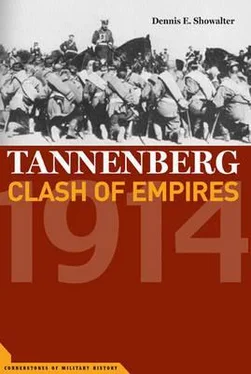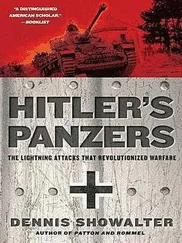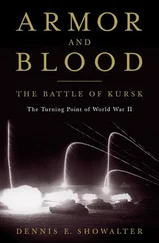His judgment is open to question. Unit for unit, in equipment, efficiency, and command, there was arguably little to choose between Habsburg and Romanov. Psychic reality, however, was more important than hindsight. In his early years as chief of staff Schlieffen believed that if the main German strength were not deployed in the east Austria might collapse completely. Much to Waldersee’s chagrin, he therefore replaced Moltke’s pincers movement with a side-by-side German-Austrian offensive from Silesia and Galicia into southern Poland. 59
This new concept left East Prussia completely exposed to a Russian attack. It meant deploying almost a million men in an area where road and railway networks were poor on both sides of the frontier. Its only advantage was the possibility of providing direct German support for an inefficient ally. And Schlieffen increasingly doubted whether the advantages of this operation justified its risks. A large part of the active Russian army was stationed on the western frontier. To expedite the deployment of the remainder, railroads were being built in European Russia with all possible speed. Russian strategic concepts had correspondingly altered. Revised war plans now incorporated one offensive from the Niemen against the German left, and another against the Austrian right flank in southern Galicia. Each ally would therefore have to secure its own respective flank before any combined operations would be possible. This in turn encouraged a tendency to establish two separate secondary theaters of war, whose geographically diverging objectives were likely to absorb critical numbers of the available troops. 60
The possibility of winning even the kind of limited victory Moltke originally projected was substantially reduced. And if the allies could cope with the new strategic situation, what would they have gained? Moltke’s original hypothesis that victory would encourage negotiation in the east depended on at least a stable front in the west. Schlieffen’s ultimate dream may have been a repetition of the victory of Cannae on a European scale. But that dream was the fruit of his nightmare: a series of meaningless victories in the east, drawing German armies even deeper into Russia while a rejuvenated France drove at the Vosges and the Rhine. 61
For all its positive qualities, however, the French army was to Germany what the German navy was to Great Britain—a challenge that no one doubted could be matched. This by no means made the French a foe to be despised. But since 1870 the French military had essentially formed itself according to patterns set in Germany. Despite specific advantages in some areas, it continued to sustain the image of a blurred copy of its original. 62Even without the advantage of a larger population, German military planners were convinced that France could be beaten both by sheer numerical superiority and man for man, corps for corps. The growing faith among Europe’s military planners in the tactical and operational superiority of the offensive only strengthened the conviction that an all-out attack on France would remove not only an immediately dangerous enemy, but the one most vulnerable to a Germany herself in no position to sustain a long, drawn-out war. 63
Schlieffen’s concern for the eastern theater also provided him with the beginnings of a solution to his greatest practical anxiety: the fundamental imbalance in manpower between Germany on one hand and France and Russia on the other. Even by training every fit man, Germany could not hope to match her enemies numerically. In an age when all armies were trained, armed, and equipped essentially alike, the prospects for securing more than a marginal advantage in quality seemed severely limited. 64These problems posed a corresponding challenge to professional skill. The window of vulnerability must become a door of opportunity. The general staff exercises of the 1890s indicated the possibilities even under modern conditions of a small force defeating a larger one by concentrating against an enemy’s flank, then driving against its lines of retreat. Far from ignoring or denigrating the power of modern weapons, Schlieffen proposed to take advantage of them by reducing the strength of covering and screening forces to what seemed an unacceptable minimum to more conservative colleagues. Instead of playing to its enemies’ strengths by a series of frontal encounter battles, the German army must seek to change the rules, to impose a plan so comprehensive, so cohesive, that the enemy whould be able to do nothing except react. 65
Orthodox general staff wisdom held that Germany’s long and exposed eastern frontier could only be defended by a strategic offensive, by thrusts into Russian territory. 66This opinion was unchallenged by Bismarck and shared by his successors, Caprivi and Hohenloe. Schlieffen for his part was willing to test the hypothesis that the east and in particular its most vulnerable area, the province of East Prussia, could be held even against heavy odds by relatively weak forces. East Prussia’s complex network of lakes, swamps, and woods offered excellent possibilities to well-trained, boldly commanded defenders. The geography of the area and the disposition of the Russian railroad network encouraged dividing invading Russian forces into two halves, one advancing westward from the Niemen, the other northwest from the Narew. And this in turn offered excellent prospects for operational ripostes that would overwhelm the invaders in detail.
The general staff exercise of 1891 featured a simultaneous Russian invasion of Posen and East Prussia, with Schlieffen’s summary highlighting the probable moral impact if even one invading column was destroyed. The problem for 1898 saw the East Prussian garrison threatened on three sides, with Schlieffen insisting the optimal response was to engage the nearest enemy force as quickly as possible, decisively defeat it, then turn against the other two adversaries. In 1899 the Germans again countered numerical inferiority by crushing one of the Russian flanks, then moving against their lines of communication.
By the turn of the century it had become a textbook solution: throw the entire German strength at whichever enemy first came within range, then concentrate against the other. Time and again the concept succeeded in war games. On one memorable occasion a general staff lieutenant-colonel charged with leading one of the “Russian” armies found himself so completely surrounded that the rules demanded a surrender. The officer insisted that no force he led would ever lay down its arms. Schlieffen, who was not without a sense of humor, amended the final report to read that the “Russian” commander, recognizing his hopeless situation, sought and found death in the front line!
Such an outcome was, however, considered an optimal result. Schlieffen had a healthy respect for the size of the Russian army, and a high regard for the uncertainties of battle. After 1901 the mobilization plan reduced Germany’s eastern force to an average of three corps, four reserve divisions, and two to four cavalry divisions. Schlieffen did not expect miracles from such a weak instrument. He recognized the possibility that a well-coordinated Russian advance, or a German defeat in the opening rounds, might require drawing troops from the west. But he also warned that once the reinforcements were on the scene, nothing would prevent the Russians from withdrawing until French pressure constrained the Germans to send troops westward, then resuming the advance. This sort of counterpunching, Schlieffen roundly declared, would lead in the long run to the complete annihilation of the German army. Instead, Ostheer should expect to fight with what it had, do as much damage as possible, and wait for the decisive victory over France. If necessary, Schlieffen was prepared to return to the concept of the 1880s, abandoning most of East Prussia and making a stand on the Vistula River. By 1903 the railway section of the general staff felt able to guarantee the transportation of eleven corps eastward as soon as France should be overthrown. And this would be only the vanguard of a German army strong enough not merely to drive Russian invaders out of East Prussia, but to pin them there and destroy them. 67
Читать дальше












